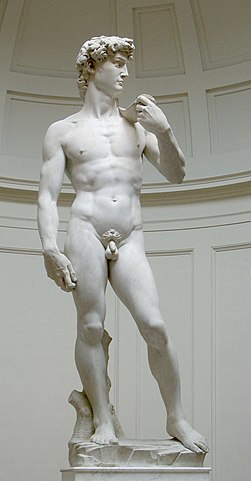Asher Kelman
OPF Owner/Editor-in-Chief
This is an interesting topic that came up here and merits its own thread. 
Jim,
A "master photographic illustrator"? Perhaps that underestimates the creative art in designing a photograph in one's mind and then capturing that on film. One should get credit for that as art don't you think? "Photographic illustrator" would not quite cover that. The great photograph is there in the negative much more than David was in the uncut stone to be revealed as "David" by Michelangelo's craft of "simply removing the excess stone"! One can already enjoy an image, albeit in the inverse, just holding it up to a window. With a transparency destined for cibachrome, the picture is already there. Surely that is fully formed art at that point?

wikimedia commons: Michaelangelo's David
With the David being hidden in the uncut block of stone that arrived at Michelangelo's workshop, no other artist could have made that sculpture appear, as it was only a form in the mind of its one creator. The same with Bresson. so this does take most of the creative deed and accomplishment of photography to the very moment of tripping the shutter, for that is when of all the possible ideas for the composition, one is chosen and that is often the time of maximal creativity.
You seem even as much of a purist than Maris Rusis! He too demands we know how to print our own work. Maybe it's better to print with an inkjet at home than sending it away for a silver gelatin print at a lab. At least with the preparation of the negative for print with custom scanning and all the adjustments needed for making a print file, one has put the image through one's own craft to make the print.
Asher
Ansel Adams said: "There can be craft without art, but there can be no art without craft." I've seen many prints of photographs by Henri Cartier-Bresson and most of them are awful prints. Sublime compositions, poor to no craftsmanship. Since he didn't do his own printing and therefore never mastered his craft, to me he was not an artist. He was a master photographic illustrator.
Jim,
A "master photographic illustrator"? Perhaps that underestimates the creative art in designing a photograph in one's mind and then capturing that on film. One should get credit for that as art don't you think? "Photographic illustrator" would not quite cover that. The great photograph is there in the negative much more than David was in the uncut stone to be revealed as "David" by Michelangelo's craft of "simply removing the excess stone"! One can already enjoy an image, albeit in the inverse, just holding it up to a window. With a transparency destined for cibachrome, the picture is already there. Surely that is fully formed art at that point?

wikimedia commons: Michaelangelo's David
With the David being hidden in the uncut block of stone that arrived at Michelangelo's workshop, no other artist could have made that sculpture appear, as it was only a form in the mind of its one creator. The same with Bresson. so this does take most of the creative deed and accomplishment of photography to the very moment of tripping the shutter, for that is when of all the possible ideas for the composition, one is chosen and that is often the time of maximal creativity.
You seem even as much of a purist than Maris Rusis! He too demands we know how to print our own work. Maybe it's better to print with an inkjet at home than sending it away for a silver gelatin print at a lab. At least with the preparation of the negative for print with custom scanning and all the adjustments needed for making a print file, one has put the image through one's own craft to make the print.
Asher
Last edited:
